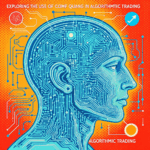Algorithmic trading, the use of computer programs to execute trades at high speeds, has revolutionized the financial markets. However, the future of this already fast-paced field is poised for even more dramatic change with the increasing integration of artificial intelligence (AI) and machine learning (ML). This article explores the exciting possibilities and challenges presented by this convergence, examining how AI and ML are transforming strategies, risk management, and the overall landscape of algorithmic trading. We will delve into the specific applications of these technologies, analyze their impact on market efficiency and volatility, and discuss the ethical considerations that arise as algorithms become increasingly sophisticated and autonomous. Finally, we will look towards the future, speculating on the potential breakthroughs and potential pitfalls that lie ahead.
AI-Powered Predictive Modeling
One of the most significant impacts of AI and ML on algorithmic trading is the enhancement of predictive modeling. Traditional algorithmic strategies often rely on relatively simple models based on historical data and technical indicators. AI, however, can analyze far larger datasets, including unstructured data like news articles, social media sentiment, and economic reports, to identify complex patterns and relationships that might be missed by human analysts or simpler algorithms. This allows for more accurate predictions of market movements and the development of more sophisticated trading strategies.
Machine learning algorithms, such as deep learning neural networks, can be trained on massive datasets to identify subtle correlations and non-linear relationships. This capability allows for more accurate predictions of price movements and volatility, leading to improved trading performance. Furthermore, AI can continuously learn and adapt, refining its models based on new data and market conditions. This adaptive capability is crucial in dynamic financial markets characterized by unexpected events and evolving patterns.
Enhanced Risk Management
The integration of AI and ML also significantly enhances risk management in algorithmic trading. Traditional risk management techniques often rely on simplifying assumptions about market behavior. However, AI can provide a more nuanced and comprehensive assessment of risk by incorporating diverse data sources and sophisticated analytical methods. For instance, AI algorithms can analyze historical market data to identify extreme events and assess their likelihood of recurrence, allowing traders to adjust their positions accordingly.
AI can also play a crucial role in detecting and mitigating fraud. By analyzing large volumes of transaction data and identifying anomalies, AI algorithms can help to detect suspicious activities and prevent losses due to fraudulent behavior. This enhanced security is particularly important in the fast-paced and high-stakes world of algorithmic trading.
Algorithmic Trading and High-Frequency Trading (HFT)
High-frequency trading (HFT), a subset of algorithmic trading that involves executing a large number of orders at extremely high speeds, is particularly well-suited to the integration of AI and ML. The speed and computational power of AI algorithms enable HFT firms to react to market changes almost instantaneously, capturing fleeting opportunities for profit. The use of AI in HFT can improve order routing, market making, and arbitrage strategies by optimizing execution speed and minimizing slippage.
However, the integration of AI in HFT also raises concerns about market stability and fairness. The increasing sophistication of AI-powered HFT algorithms could exacerbate market volatility and create an uneven playing field for smaller participants. Regulators are constantly working to address these concerns and ensure the fair and orderly functioning of markets.
Ethical Considerations and Regulatory Challenges
The increasing use of AI and ML in algorithmic trading raises several ethical and regulatory concerns. One major concern is the “black box” nature of some AI algorithms, which makes it difficult to understand how they make decisions. This lack of transparency can make it challenging to identify and address biases or errors in the algorithms’ logic. Furthermore, the autonomous nature of sophisticated AI algorithms raises questions about accountability in cases of trading losses or market manipulation.
Regulatory bodies are grappling with the challenges of overseeing AI-driven trading strategies. New regulations may be needed to ensure transparency, accountability, and fairness in the use of AI in financial markets. These regulations need to strike a balance between fostering innovation and mitigating potential risks.
The Future of Algorithmic Trading
The integration of AI and ML is fundamentally reshaping the landscape of algorithmic trading. The ability of AI to analyze vast datasets, identify complex patterns, and adapt to changing market conditions is transforming trading strategies, risk management, and market efficiency. AI-powered predictive models, enhanced risk management tools, and sophisticated HFT algorithms are enabling traders to achieve greater returns and manage risks more effectively. However, the increasing sophistication of AI also raises ethical and regulatory challenges that must be addressed to ensure the fairness and stability of financial markets. Looking ahead, we can expect continued innovation in the application of AI and ML to algorithmic trading, driving further efficiency and potentially leading to both opportunities and significant challenges for market participants and regulators alike.
In summary, the convergence of algorithmic trading, AI, and machine learning is creating a dynamic and transformative landscape in the financial world. We have explored the enhanced predictive modeling capabilities, improved risk management strategies, and the profound impact on high-frequency trading. However, we must acknowledge the ethical considerations and regulatory challenges that accompany this technological advancement. The future necessitates a balanced approach, fostering innovation while actively addressing potential risks and biases to ensure a fair and stable market for all participants.
| Aspect | Impact of AI/ML Integration |
|---|---|
| Predictive Modeling | Improved accuracy, identification of complex patterns |
| Risk Management | Enhanced risk assessment, fraud detection |
| High-Frequency Trading | Increased speed, optimized order execution |
| Ethical Considerations | Transparency, accountability, bias mitigation |
References
Investopedia: Algorithmic Trading
Kaggle: Financial Data Datasets
arXiv: Research Papers on Algorithmic Trading and AI
Image By: Black Forest Labs






